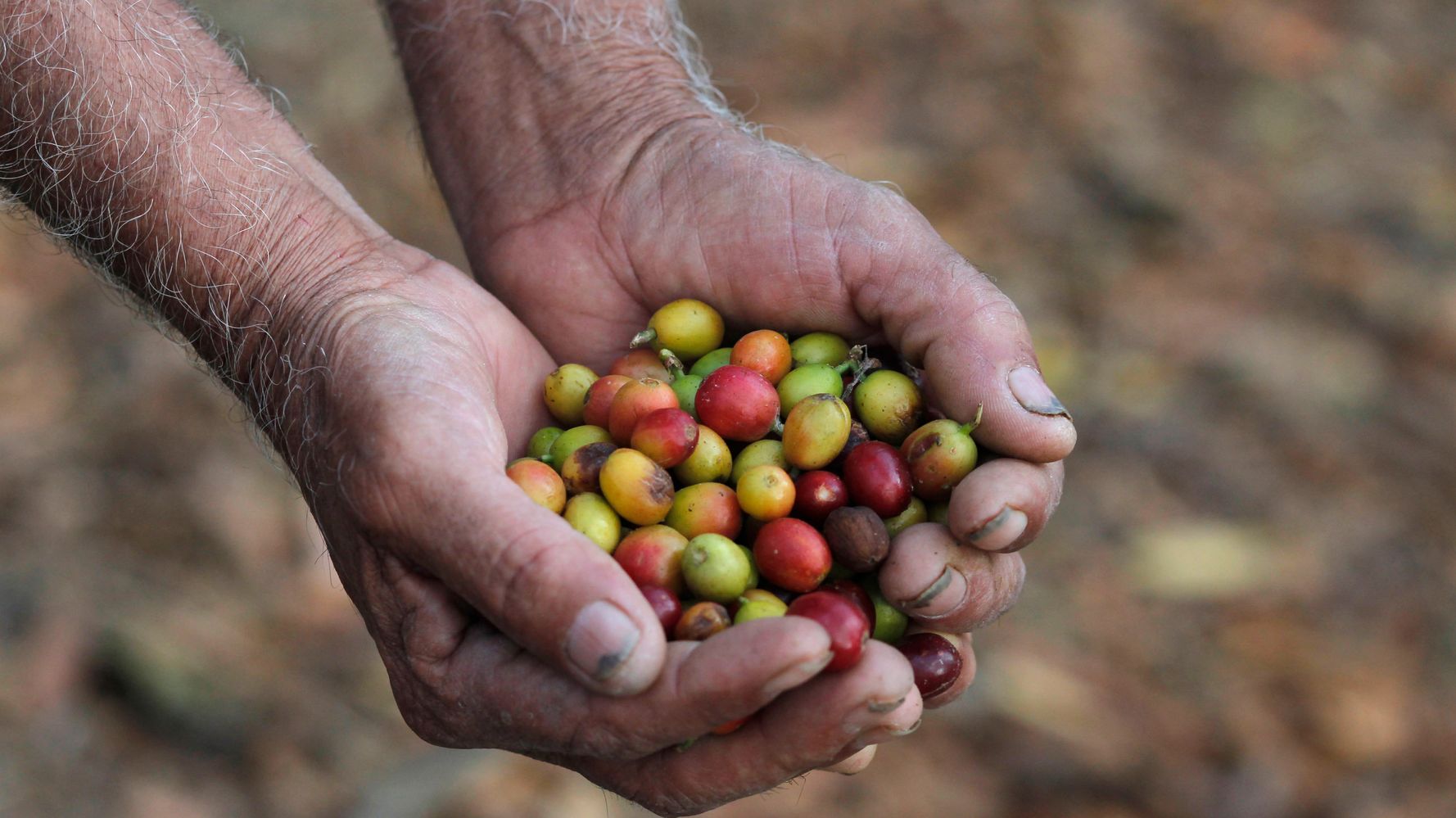
JUMAYTEPEQUE, Guatemala ― Junior Dario “J.R.” Henriquez* started thinking about heading north on the long, hard migrant trail to the United States when the coffee plants started withering. Drought and a pernicious fungus called roya ― coffee rust ― were wreaking havoc on the plantation here, where J.R. worked as a day laborer. An especially debilitating drought had suffocated this part of Guatemala since 2014 and the rust, which proliferates in lower altitudes, higher temperatures and among stressed plants, was spreading across the leaves like an accumulation of stains. Instead of full blooms of coffee berries packed thick on the branches like spangling beads, the plants were paltry and sparse, the leaves wilting on the branches.
The manager of the farm where J.R. was working announced he was cutting workers one day in 2015. There was little to do on the dwindling farm. J.R. kept his job but several of his friends, including his younger brother, lost theirs. Even J.R. was infrequently called to work. Weak crops meant less work, and less money. There used to be plenty to do around here during the harvest, so the young men who had been laid off looked for work on the other farms. All they found were more dry plants and thin harvests.
Despite being less than two hours from Guatemala City, the lush and tropical capital of the country, the hills that curl through the Santa Rosa region where J.R. and his friends are from, look more like the brown, gasping loam of Northern California, where I’m from. This region is known as the “dry corridor,” and it stretches from southern Guatemala into northern Honduras and El Salvador. When I visited in January it hadn’t rained since October, and it likely won’t rain again until at least April, maybe May or June. The conditions in January were more like they should have been in April, in the last stretch of pre-rain: the soil dry and flaking, already thirsty for the rain still months away.
Even after all that I’d read and heard, I was unprepared for the state of the blighted coffee plantations I visited. The desiccated earth scattered down the hillside easily beneath my steps, and the air felt torrid and listless. The coffee rust had taken over most plants. Many appeared stressed beyond saving. Only a few berries clung to some branches. Others had dropped their rust-infected leaves, and some were entirely bare ― just thirsty sticks poking up from the earth, waiting.
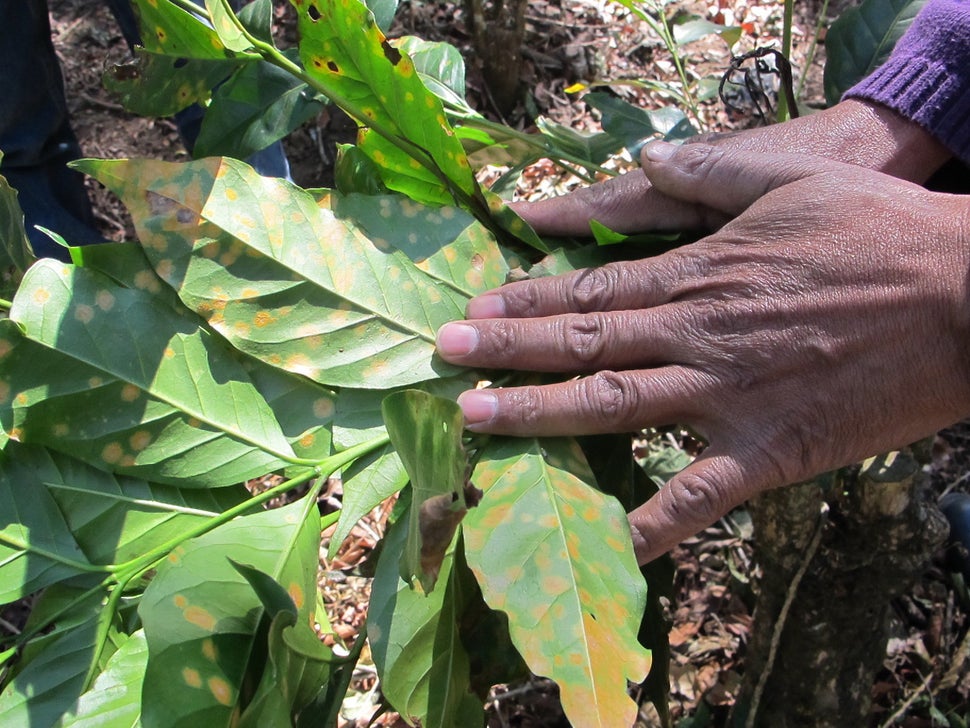 The early signs of coffee rust, a blight worsened by the impacts of climate change, on a coffee plant in Guatemala’s dry corridor.
The early signs of coffee rust, a blight worsened by the impacts of climate change, on a coffee plant in Guatemala’s dry corridor.Across the dry corridor, communities rely on subsistence farming for survival. Due to the drought and irregular rainfall of the past several years, the region has experienced crop losses of between 50 and 90 percent. According to the United Nations, as of June 2016, an estimated 3.5 million people ― a third of the dry corridor’s population ― required humanitarian assistance as a result.
Most people in Santa Rosa grow and sell coffee, and though some have supplemental food crops, many rely entirely on it for income. The deterioration of the coffee-growing environment has a massive impact on Guatemalans’ ability to make a living, and to buy food. According to ANACAFE, the Guatemalan national organization of coffee growers, more than half a million Guatemalans rely directly on the coffee harvest for employment.
In addition to the drought, between 2010 and 2014 alone, coffee rust caused an estimated $500 million in damage throughout Central America’s coffee harvest. The fungus has long been a problem for coffee farmers but is made worse by climate change. Because of rising temperatures, the rust is moving to higher and higher elevations; without significant and vigilant remediation, it decimates crops. Erratic rainfall doesn’t help — the normal early rains help wash away the fungus from the leaves, and well-hydrated plants are less stressed and more resistant to disease. These climatic changes, coupled with poor agricultural practices like crop crowding and poor fumigation, create optimal conditions for coffee rust and other plagues. For years, coffee farmers in Central America would simply plant their crops and go back later to harvest the beans. Today’s conditions require much more vigilant agricultural practices.
‘People are just there, not earning anything, and they think, “what will we do?”‘
“The lowland areas where coffee is grown ― they are hit hardest,” explained Maarten van Zonneveld, a scientist with Bioversity International who specializes in coffee. The lowlands are closer to the Pacific, “so more vulnerable to extensive droughts caused by El Nino,” he told me.
Worldwide, coffee is a massive global cash crop, worth $19 billion a year and employing 125 million people. Demand increases 5 percent each year. But the crop is in peril all around the world ― climate change is wreaking havoc on coffee farms from Uganda to El Salvador to Vietnam. According to an October 2016 report commissioned by the Climate Institute in Australia, “Without strong action to reduce emissions, climate change is projected to cut the global area suitable for coffee production by as much as 50 percent by 2050. By 2080, wild coffee, an important genetic resource for farmers, could become extinct.”
What will happen to all those farmers?
 An agronomist for Coffee & Climate on a blighted coffee plantation.
An agronomist for Coffee & Climate on a blighted coffee plantation.Over the last few years, the number of unauthorized immigrants arriving on America’s southern border from Central America has spiked. It’s a phenomenon linked to a complex vortex of entrenched poverty, gang violence, family separation and a lack of opportunity throughout the region. Between October 2015 and September 2016 , according to the U.S. Customs and Border Protection, nearly 75,000 Guatemalan migrants were apprehended along the southern border, compared to under 17,000 in 2010. One of the least discussed reasons for this migration is climate change, especially its impact on food security and jobs. Climatic factors are pushing an increasing number of people out of Guatemala and elsewhere in Central America. Few industries have been hit as hard as coffee.
“Our country’s migration is deeply linked to agriculture,” said Alejandra Gordillo, the executive secretary of CONAMIGUA, the Guatemalan government’s national organization supporting migrants. “Climate change is obviously affecting this,” especially in the dry corridor. This region has been dry as long as anyone can remember, but the drought of the past several years has been unusually harsh, especially on farmers in poor, rural areas. “People are just there, not earning anything, and they think, ‘what will we do?’” Gordillo said.
Up on a dry, rust-plagued hillside, Manuel, a young agronomist from an organization called Coffee & Climate, which is funded by, among other organizations and companies, Starbucks and the fast food chain Tim Hortons, stuck an instrument that measures moisture levels into the dirt. The needle hardly moved at all, not budging out of the red zone. Dry.
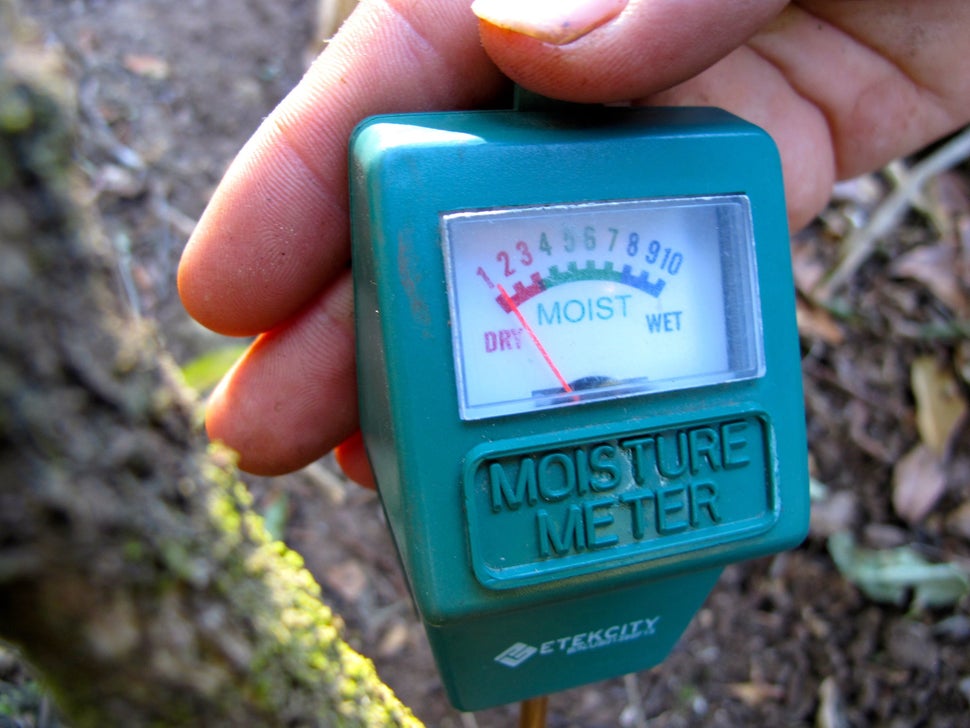 In the midst of a prolonged and worsening drought, the soil is dry, leaving plants more vulnerable to plagues like coffee rust.
In the midst of a prolonged and worsening drought, the soil is dry, leaving plants more vulnerable to plagues like coffee rust.When the rain does come, Manuel explained, the soil is so dry that the water doesn’t really get absorbed. It cascades down the hillside, eroding the soil and taking away the fertile top layer, putting the plants in an even more precarious position. The more stressed they are, the more susceptible they are to the coffee rust and to other plagues like fiebre amarilla ― “yellow fever.”
This dizzying cycle reminded me of ice sheets melting, in Greenland for example. As the surface ice melts, it creates rivers of meltwater that rush into the interior of the ice. The rushing water causes more ice to melt, and the water eats away at the ice in a vicious cycle. In the same way, drought causes landslides and stresses the coffee plants, and that helps cause coffee rust, which stresses the plants even more. On and on and on. Worse: the rust is airborne, so an outbreak in one area can decimate a nearby farm, even if farmers are going to great pains to mitigate and prevent outbreaks.
“Here, we live off coffee,” a woman who lived on the next hill told me. Her husband left her to go north five years ago and used to send money home, which she used to support her withering coffee crops by buying fungicide and rust-resistant varieties of coffee. Then he stopped. “He took up with another woman,” she told me and shrugged. No more remittances. She fends for herself now amid a lengthening dry season and the creeping plagues.
‘Here, we live off coffee.’
The impact of climate change on the coffee industry is so stark that coffee companies are investing in adaptation. Coffee & Climate is supporting mitigation efforts in the region: training farmers to plant evenly spaced shade trees in the plantations to keep the sun from drying out the coffee plants and encouraging terracing and cover crops, which prevents erosion and keeps moisture in the ground. Coffee & Climate’s staff, along with ANACAFE, also trains farmers and local promoters on how to test the soil to gauge what kind of fertilizer is needed and to use a graduated system of fungicide — from organic all the way up to the strong chemical grade — at the onset of coffee rust. But these efforts take time — years, sometimes — before they begin to fundamentally shift crop yields.
These organizations also provide access to rust-resistant varieties of coffee, though the quality of these is widely believed to be lower than the native plants. A mix, then, is most often recommended. Meanwhile, ANACAFE is setting up meteorological stations throughout the region to collect data related to sky and ground temperature, wind strength and direction, humidity and precipitation. The goal is to create future models that will allow farmers to better predict the increasingly erratic weather and plan accordingly.
“With climate change, you really need to be preventative, not reactive,” Pablo Ruiz, a coordinator at the Guatemala branch of Coffee & Climate, told me. But with climate change so rapidly damaging the environment, scientists, citizens, farmers and governments are racing to catch up, always trailing behind.
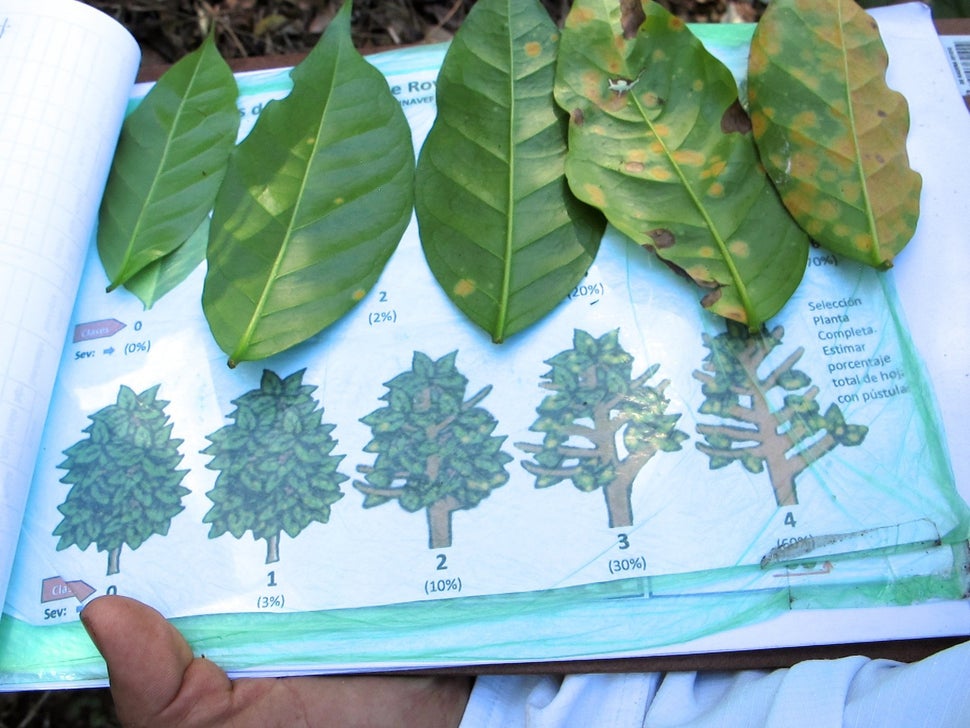 A Coffee & Climate agronomist demonstrates the evolution of coffee rust.
A Coffee & Climate agronomist demonstrates the evolution of coffee rust.“We use research to guide our interventions,” Ruiz explained. “But we also get feedback from the communities.” Several months after planting cover crops in one area, Ruiz said, “The farmer asked me, ‘Have you seen all of the worms in the soil?’” That was new, the farmer insisted. It signaled that the soil was healthier than before. “Now we use worms as a measure of soil health,” Ruiz said. “So we learn from the farmers too.”
Younger farmers, Ruiz went on, seem more open to interventions and new techniques. But at the same time, laden with hope and aspirations, young farmers seem to be less patient with the situation overall. J.R. could see his future laid out before him: no work, every year harder than the last, less food, no money. Moving was his only hope.
“It’s the young ones who go most,” an elder farmer told me while surveying her new coffee crop, which was planted with support from Coffee & Climate and would serve as a demonstration plot for climate mitigation practices. Often, they’ll leave for Guatemala City and find what work they can — washing cars, cleaning houses, working in restaurants or construction. “Lo que hay,” she explained. “Whatever there is.” But they’ll leave for the U.S. too, starry-eyed with the possibility of chasing the American dream.
J.R. considered going to the city. But he didn’t have contacts there, and he couldn’t think of what he’d do. Plus, he was wary of the gang violence spreading through the country like a plague. His older brother lived in the U.S. and agreed to send him money to hire a coyote — a human smuggler — at a cost of $10,000. It was a high price, but at least there was no interest. Many migrants from the region take out high-interest loans from shady local brokers — sometimes with 10 percent compounding monthly interest — and put up their homes or land for collateral. People throughout Santa Rosa told me that many people lose their homes this way.
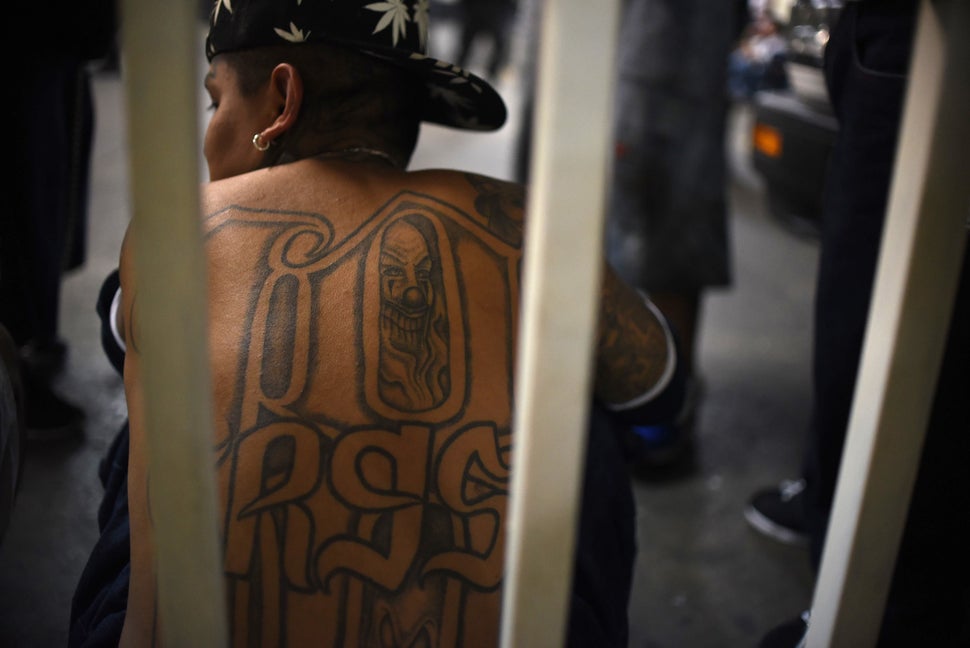 A member of the Mara 18 gang in the Supreme Court building in Guatemala City on Sept. 30, 2015.
A member of the Mara 18 gang in the Supreme Court building in Guatemala City on Sept. 30, 2015.All around the world, young people like J.R. have their eyes on the horizon, and it’s not surprising that Guatemala’s youth are particularly restless. According to U.S.A.I.D., Guatemala is home to more than two million young people aged 15 to 24 who lack the education and vocational skills to enter the workforce. Guatemala is the largest Central American economy but the wealth is largely concentrated at the top of society. And the country’s poverty rate has increased in recent years, particularly in rural areas like Santa Rosa.
J.R. knew he couldn’t make it work in the coffee business or in the fields, and he didn’t have the education or training — much less the money to acquire it — to find other jobs. He told me, “I left my heritage, my home, for [the] opportunity for something better.” It’s a choice he didn’t take lightly, he said. He knew he was risking never seeing his family again or dying on the journey north.
In September 2015, J.R., along with two friends, left Guatemala and traveled across the border into Mexico, traversing the length of the country. In Mexico, he was separated from his friends and crossed into the U.S. with a group of six other Guatemalans and a coyote. Their group — all people in their 20s and 30s — hiked through the Arizona desert for days to avoid being spotted by the U.S. immigration authorities. It was exhausting and deathly hot. Near the end of the journey, within earshot of a road, one of the men sat down.
‘It’s the young ones who go most.’
“I can’t go anymore,” he said. “I can’t go on.” He told the group to press ahead. They gave him their food and reluctantly left him behind. J.R. hoped the man would regain his strength and be able to walk toward help. But he knew the odds. He never found out what happened to him; it’s possible, if not likely, that he perished there in the desert ― thirsty, hot and alone far from home.
People have been leaving the Santa Rosa region — and all of Central America — for a long time. But climate-driven migration is a newer phenomenon. Israel, a Santa Rosan man in his 40s who preferred we only use his first name, told me it seemed like more people migrate now, a sentiment I heard throughout the region. In 2002, Israel moved to the U.S., stayed for six years, saved some money and then, when the economy tanked, came back — “self-deported,” as he put it. His plan was to go home to his family and invest in land so he could grow coffee. He was devastated to find the coffee gasping for life in the once prosperous region. “How to survive here?” he asked, motioning to the plants, splotched with brown-yellow blooms of rust.
Coffee & Climate and other agencies are also encouraging the formation of cooperatives that allow farmers to band together and access larger markets for their beans, while also supporting one another with mitigation efforts. Israel meets with his cooperative every week at his friend Manolo’s house, which is perched on the top of a hill where ANACAFE will soon build a new meteorological station. The station will help plan when to plant and when to harvest, so farmers can do more than just operate on gut instinct and defunct traditional timeframes. Like Israel, Manolo also migrated to the U.S. and then came home.
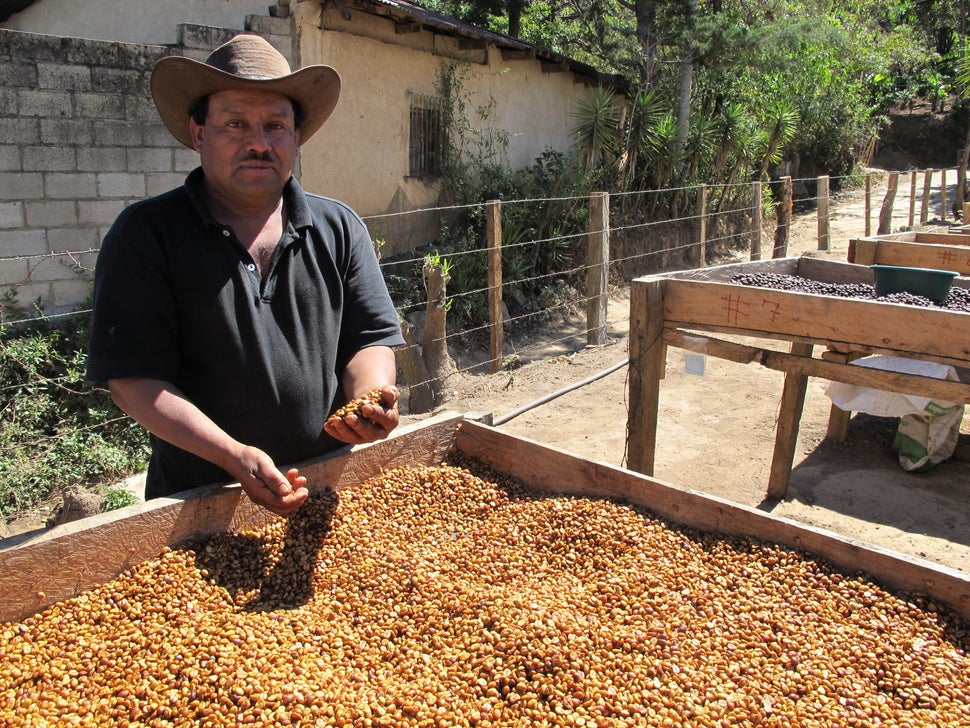 A coffee farmer and other members of his cooperative in Nueva Santa Rosa have built drying racks for the coffee beans.
A coffee farmer and other members of his cooperative in Nueva Santa Rosa have built drying racks for the coffee beans.Behind Manolo’s house, members of their cooperative have built drying stations that are now filled with the beans from a recent harvest. Some are bone dry, others are fermenting in the sugars of their own pulp. This is called honey coffee, and it fills the area behind Manolo’s house with a sweet-drunk smell. The drying bins are covered with a black mesh that provides dappled shade, allowing the beans to dry slowly and accumulate more desirable flavors. Selling the beans already dried — instead of fresh-picked and still in their husks — brings the cooperative members a higher price. Plus, it cuts costs to pool their beans, labor resources, finances and equipment.
The farming population in Guatemala is aging, Coffee & Climate’s Ruiz explained, because so many young farmers, or would-be farmers like J.R., are leaving. To keep the coffee business alive, they need more people like Manolo and Israel to stick with it, to find a way to make coffee farming profitable again.
“It’s so much less,” Israel said of the harvests. “But what can we do?” He keeps working, learning new methods to retain water and avoid the coffee rust and other plagues. Israel and Manolo have both already been to the U.S. and back, and they know what awaits people there — long working hours, racism, the constant fear of deportation ― all of which they anticipate getting worse under President Donald Trump. They want to make a go of it in the coffee business at home. But they understand why the youngsters like J.R. go. They did too, after all.
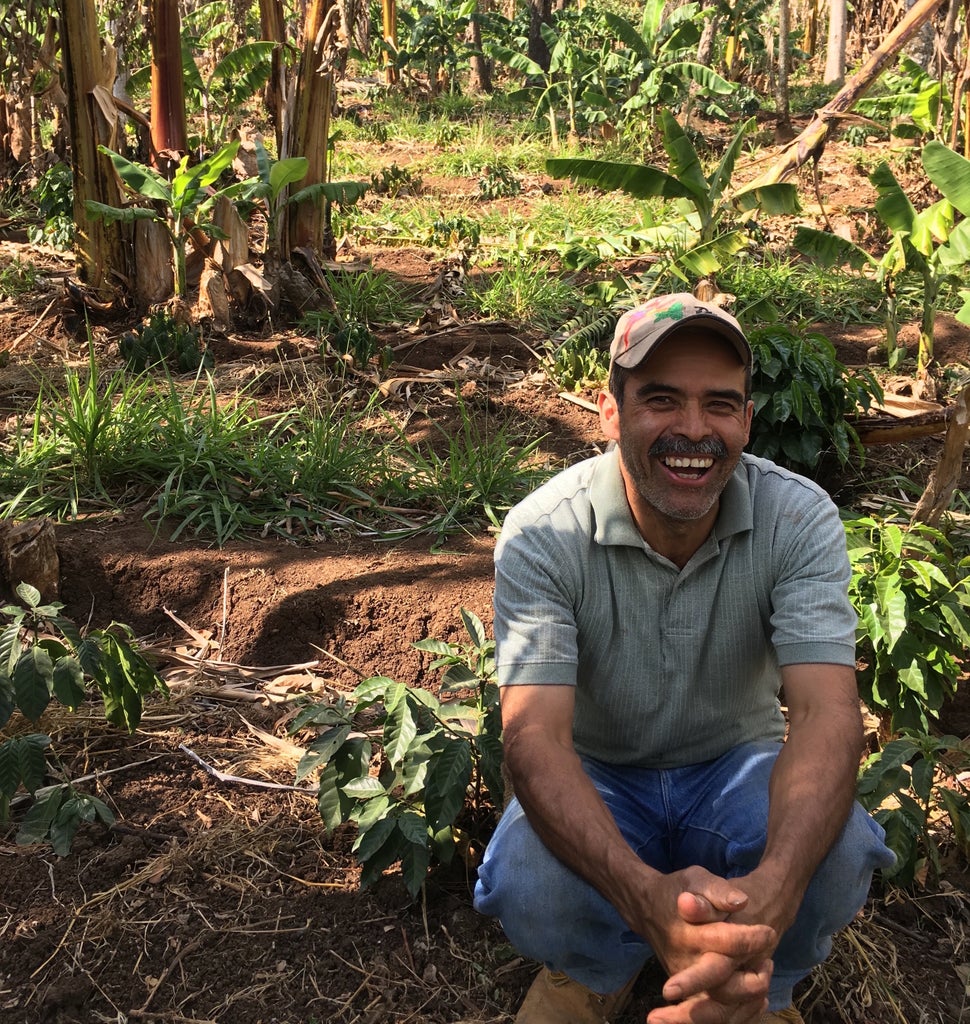 A farmer on a newly planted coffee plantation that employed remediation techniques to guard against the impacts of worsening drought conditions. El Bosque, Guatemala.
A farmer on a newly planted coffee plantation that employed remediation techniques to guard against the impacts of worsening drought conditions. El Bosque, Guatemala.J.R., Manolo, Israel and others who left Santa Rosa because they couldn’t make a living in the fields anymore would be considered economic migrants: people who left their countries in search of a better economic opportunity. There is no international protective framework or form of immigration relief for such migrants. And beneath the economic factors driving migration around the world — from Bangladesh to Uganda to Guatemala — there are often environmental ones.
In many countries, climate change is fundamentally altering the growing season, and sometimes eliminating it altogether. According to the United Nations refugee agency, an average of 22.5 million people were displaced by “climate or weather-related events,” like typhoons and flooding, each year since 2008 ― a figure that does not include slow-onset change like sea level rise or drought. Climate change will only magnify these trends. Yet if someone’s survival in her home country is in jeopardy because of climate change and she crosses an international border, she will find no grounds for protection or relief on the other side.
“We often tend to oversimplify these concepts to look at humanitarian crises in terms of a dichotomy — conflict versus natural disasters,” António Guterres, then the UN’s High Commissioner for Refugees, said in a speech in December 2015. “We treat them as two big streams of displacement. We measure their consequences differently. We design our responses to them differently.”
Migration is its own form of adaptation.
Guterres went on to say that we need to “step back and look at the underlying causes as what they are — multiple, interlinked, overlapping and mutually reinforcing factors that accumulate and contribute to eventually driving people from their homes.” This is especially true in Guatemala, El Salvador and Honduras. Increasing gang violence, entrenched poverty and climate change are all factors that collude and collide, pushing more and more people out of their homes.
The warming world is caught up in a complex dance with global migration. Since time immemorial, humans have moved to survive. Today is no different. But in recent years, the barriers to migration have intensified ― walls are being built, nativist and nationalist governments are coming to power and becoming a citizen in a new country is more difficult.
What is happening in Guatemala is, in many ways, a harbinger of what is to come throughout the region, and the world. From Somalia to South Sudan to Afghanistan, environmental stressors often break the backs of vulnerable communities in tenuous societal conditions. And when the environmental stressors force permanent shifts in people’s way of life, adaptation becomes a tricky business. Already, migrants by the thousands are fleeing from Central America to the U.S., from low-lying Pacific islands to Australia, from the Sahel to Europe. Migration is its own form of adaptation.
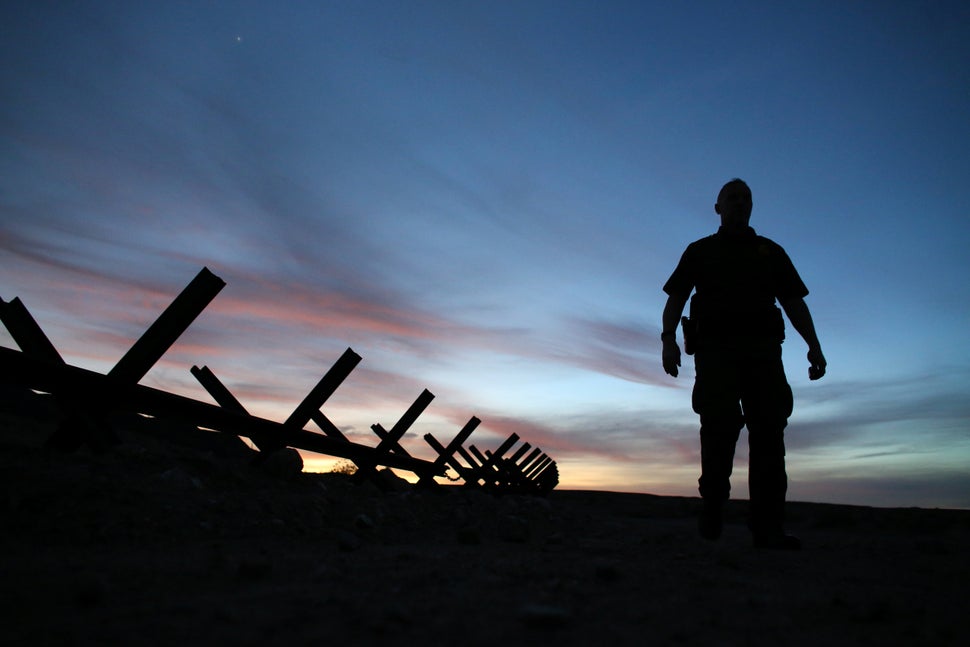 U.S. border patrol agent Alessio Faccin walks along the border fence separating Mexico from the U.S. near Calexico, California. Feb. 8.
U.S. border patrol agent Alessio Faccin walks along the border fence separating Mexico from the U.S. near Calexico, California. Feb. 8.I asked a group of women in the Santa Rosa region what they might say to people who didn’t believe in climate change. They were quiet and looked puzzled. “But it’s happening,” one said.
“That they don’t believe there’s a change?” one clarified. That’s right, I responded. Of course there’s a change, they explained patiently, like they might to a child. Out in the fields, they get sunburned now when they never did before. The sun is so strong that they have to start work even earlier in the morning, before sunrise, to avoid the scorching rays.
Van Zonneveld, the scientist with Bioversity International, hasn’t met climate skeptics in his extensive work throughout Central America either. People on the front lines of climate change can’t afford to wait around for help. “If you are in such a vulnerable position, you don’t have the luxury to wait for others to come with solutions,” he said. “You have to find the solutions yourself … independent of the political situation.”
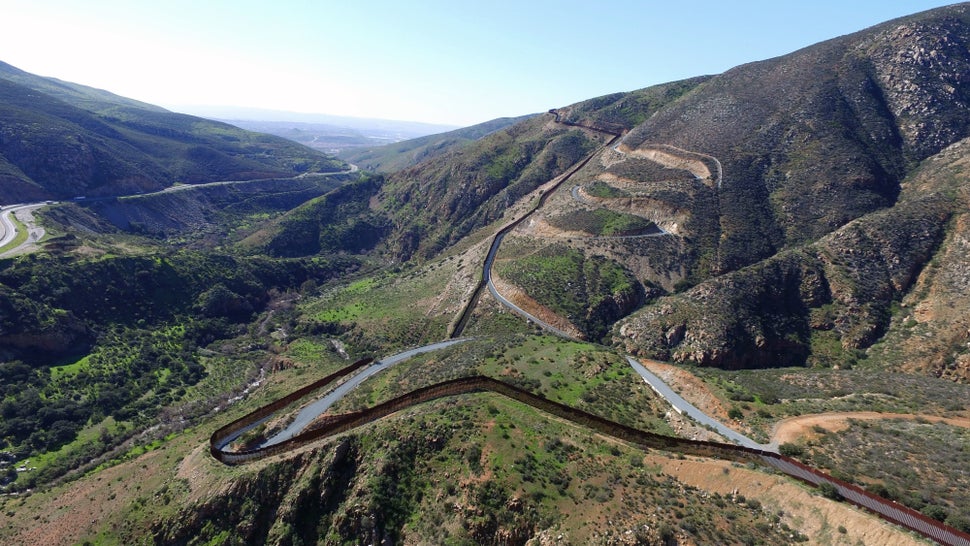 The border between the U.S. and Mexico on the outskirts of Tijuana, northwestern Mexico. Jan. 26.
The border between the U.S. and Mexico on the outskirts of Tijuana, northwestern Mexico. Jan. 26.J.R. lives in New Jersey now. He works six days a week at a carwash. “Except,” he said, not acknowledging the irony, “when it rains.”
“I wouldn’t say I’m happy here,” he told me. He’s far from his family and everything he knows. And there’s the ever-present, unshakable fear of being caught and deported. “A person never really feels free,” he said.
Fear is always a dynamic is his undocumented life in the U.S., but it’s become more acute since Trump was voted into office. “All the things he says about immigrants,” J.R. said, then trailed off. He’s more afraid at work now, afraid of being found out for being undocumented, and he feels less steady walking around town. He avoids watching the news ― it only adds to his stress.
On Wednesday, the day before a national strike among immigrant communities, J.R. got wind that raids by Immigrations and Customs Enforcement were coming to his New Jersey town. It may have just been a rumor ― but how could he know for sure? He’d seen the news of ICE raids in other parts of the country. He became anxious and had trouble sleeping. He didn’t know whether it was safer at work or at home.
The new administration has already started deporting some immigrants (those with criminal records and those with no records at all), and has caused others to seriously consider going home on their own. But even as news of the raids emerged, J.R. still felt like he wasn’t ready to go home. He’d committed to helping his family carve out a better life in Guatemala, and he wants to make sure his younger brother can finish school “and become someone” in life. So long as he can stay under ICE’s radar, he’s not going anywhere, even if that means a more tenuous life than ever in the U.S.
If he has a choice, will he go back eventually, like Israel and Manolo did? He said he wants to, of course. These days, it’s even harder for him to picture a long-term life in the U.S., constantly fearing getting picked up and dragged back home with nothing to show for it.
If he can manage to stick it out up north for long enough, and evade the authorities, maybe he could save enough money to buy a small farm of his own back home in Guatemala. It depends, he said, on what happens with the rain.
This was produced by The WorldPost, which is published by the Berggruen Institute.
* J.R.’s last name has been changed for security reasons.

